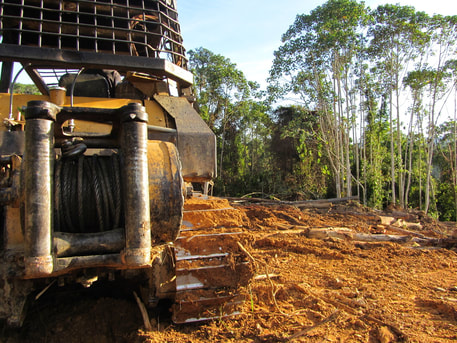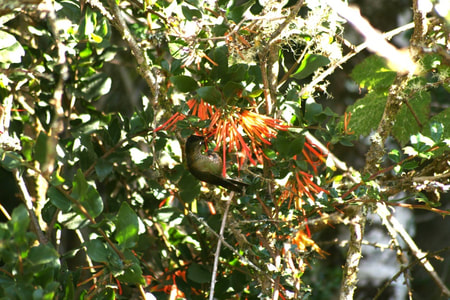Main Research Lines
Impact of human activities on ecosystem functioning
|
Up to now, my research in this area has focused on selective logging, forest fragmentation and agricultural expansion. Critical questions I have focused on are (1) community-level impacts of disturbance using network theory (2) linking changes in network structure to ecosystem functioning and (3) how to improve biodiversity values within farmland areas without negatively impacting yield. My work has been carried out in Borneo, India, Australia, Brazil, Chile and Spain.
|
Identifying cost-effective solutions to halt biodiversity loss

- I am interested in finding cost-effective opportunities for biodiversity conservation and do so by focusing at the nexus of biodiversity values and economic costs. In particular, I have worked on the potential for ecosystem services, such as pollination services to crops and other payments for ecosystem services (e.g., carbon-based ones such as REDD+) to offset the opportunity costs of agriculture development and thus support conservation. My work in this area has been primarily carried out in India and Brazil.
Research projects
Hummingbird functional roles along a latitudinal gradient

Understanding the consequences of species loss for the functional capabilities of ecosystems is critical given on-going global change. The role a species plays in a community has been demonstrated to be dynamic and dependent on species composition. However, what remains unresolved is how species diversity modulates these dynamic functional roles and what the consequences are at the community level. To fill this gap, this project is currently evaluating structural changes in plant-hummingbird interaction networks within communities harboring resident and migratory hummingbird species along a latitudinal gradient of increasing species diversity from central Mexico to Alaska. The project will survey plant and hummingbird communities in the presence and absence of the migratory species to evaluate changes in species functional roles and community structure.
EvaluaTing the functional role of the hummingbiRd hAwkmoth, Macroglossum stellatarum aloNg itS mIgratory paThway: implications for ecosystem functioning (TRANSIT)

Predicting how species, communities and ecosystems will respond to global environmental change remains a key scientific challenge. Much progress has been done in understanding how species interact and assemble into complex networks. However, the dynamic nature of these species assemblages and the role of biodiversity in shaping them remain poorly understood.To fill these gaps, we will survey plant-pollinator interactions along the migratory pathway of the hummingbird hawkmoth, Macroglossum stellatarum, which coincides with a pollinator diversity gradient, to address three main questions:
1. How does pollinator species diversity within the community and the migratory behaviour of a species affect its functional role?We will evaluate how M. stellatarum´s functional role changes throughout its migratory pathway: from Spain where migratory and resident populations co-exist, to Switzerland where all individuals annually migrate in late May, and the consequences this has for plant reproductive success.
2. How does pollinator functional diversity affect ecosystem function?We will focus on the relationship between community dynamics and the spatial network of pollination events generated by different pollinator species, including M. stellatarumalong its migratory pathway, and test the effects for population persistence and potential longer-term evolutionary responses.
3. How will climate change affect M. stellatarum´s migratory behaviour and what will the consequences be for ecosystem functioning?We will evaluate how climate change might affect the migratory behaviour of M. stellatarum, and the consequences this might have for other pollinator species it co-exists with. We will develop models based on the knowledge generated in previous objectives to predict how communities will re-assemble and use them together with process-based models to forecast effects on ecosystem function.
By connecting empirical data with complex theoretical models, TRANSIT will represent a fundamental step to improve our ability to predict the outcome of ecosystem disturbances and their impact on community structure and function, while focusing on multiple levels of biodiversity: from species, interactions and communities to functions.
1. How does pollinator species diversity within the community and the migratory behaviour of a species affect its functional role?We will evaluate how M. stellatarum´s functional role changes throughout its migratory pathway: from Spain where migratory and resident populations co-exist, to Switzerland where all individuals annually migrate in late May, and the consequences this has for plant reproductive success.
2. How does pollinator functional diversity affect ecosystem function?We will focus on the relationship between community dynamics and the spatial network of pollination events generated by different pollinator species, including M. stellatarumalong its migratory pathway, and test the effects for population persistence and potential longer-term evolutionary responses.
3. How will climate change affect M. stellatarum´s migratory behaviour and what will the consequences be for ecosystem functioning?We will evaluate how climate change might affect the migratory behaviour of M. stellatarum, and the consequences this might have for other pollinator species it co-exists with. We will develop models based on the knowledge generated in previous objectives to predict how communities will re-assemble and use them together with process-based models to forecast effects on ecosystem function.
By connecting empirical data with complex theoretical models, TRANSIT will represent a fundamental step to improve our ability to predict the outcome of ecosystem disturbances and their impact on community structure and function, while focusing on multiple levels of biodiversity: from species, interactions and communities to functions.
INTGR8: Integrative modelling to understand pollination services across agricultural landscapes

INTEGR8 aims to understand how pollination services are distributed in space and time across large spatial scales in order to use this information to 1) raise awareness about pollinators and their declines, 2) inform decisions taken within agricultural landscapes that affect pollinator populations and the delivery of pollination services, and 3) explore and recommend alternative land use practices that are less harmful for pollinator species. The ultimate goal of the project is to contribute to the conservation of pollinator diversity and pollination service delivery within human-dominated landscapes in South Africa .



